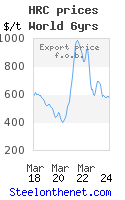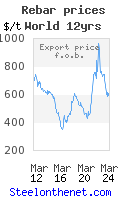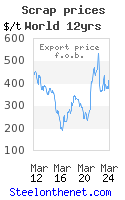Posco - all about India's biggest FDI project
The following article about POSCO's proposed new steel industry investment appeared on www.rediff.com today. For original article, see here: http://www.rediff.com/money/2005/aug/23posco.htm
On June 22, 2005 Posco, the world's fifth largest steel maker, entered into a pact with the Orissa government for an eventual investment of $12 billion -- or Rs 52,000 crore -- for setting up a steel plant in the state.
It is single largest foreign direct investment in India, but little is known about Posco in India. So what is it? Read on...
Posco is Pohang Steel Company, the world's fifth largest steel company based in South Korea. On April 1, 1968, under the leadership of Tae Joon Park and 39 employees, Posco began life with hardly any capital or expertise. The grit and determination of the employees saw Posco scale new heights. In 1973, the first production line manufacturing 1.03 million tonne of crude steel was completed and Pohang Works -- with a 9.1 million tonne production line for crude steel -- was established in 1983, after four expansions.
Biggest FDI project in India? Posco signed an MoU for setting up a steel plant at Paradip in Orissa with a total investment of $12 billion (Rs 52,000 crore). It is the biggest foreign direct investment in India. The project will be completed in two phases. Each phase will consist of two modules of 3 tonne per annum. The first module is expected to be completed by June 2010. Thereafter, 3 million tonne capacity will be added every two years and the plant will reach its full capacity of 12 million tonne by 2016.
Who heads Posco now? Ku Taek Lee is Posco's chairman and chief executive officer. He began at the entry-level position in Posco and has now risen to lead the company. Lee joined the company in 1969. The 58-year-old chairman believes in innovation. According to him, companies that do not innovate have no future.
From scratch to success... The implementation of plans, the efficient facilities and the increase in productivity of crude steel pushed Posco to the top of the world's steel industry in 1998. In 1994, it was listed on the New York Stock Exchange. In 1995, the company was listed on the London Stock Exchange, even as it sought to expand its global reach. The company revamped business in 1999, improving production and sales. It received the ISO 9002 certification in 1999. Posco was privatised in 2000. From 2004, Posco has been evaluated as a top global company with corporate transparency and a sound financial structure. The company aims to increase its production to 50 million tonne by 2010 from its current level of 30 million tonne.
How will Posco go about this huge task? Posco plans to set up a company registered in India in August. The Indian company will set up the integrated steel plant and apply for the mining leases. After conducting detailed investigations and economic feasibility analyses, it will acquire land, finalise a rehabilitation and resettlement programme, and sign a final memorandum of agreement later this year.
Who will benefit from Posco? The project, which would start with a 3 million tonne capacity initially, would fetch revenue for the government to the tune of Rs 700 crore to Rs 800 crore (Rs 7-8 billion) annually. It would provide direct employment to 13,000 people and ensure indirect employment for another 35,000.
Why has Orissa become a hot spot for steel companies? In the last one-year, about 40 proposals for setting up steel plants in Orissa have come up. Orissa assures long-term reserves of high quality iron ore, surplus and cheap electricity and easy access to major steel consuming markets and raw material sources. With 3,567 million tonne of iron ore reserves, 26.50 per cent of India's reserves are in Orissa. The state has substantial reserves of other minerals which go into steel making, like coal -- 51,571 million tonne (24.37 per cent of the national deposit), dolomite -- 434 million tonne (10 per cent) and limestone -- 1,032 million tonne (1.36 per cent). Five major national and international players are pumping in Rs 95,400 crore (Rs 954 billion) to build 32.5 million tonne capacities in the state. The Australian BHP-Billiton, has tied up with Korean steel major Posco to invest Rs 39,000 crore (Rs 390 billion) for a 10 million tonne capacity plant.
Why is there an opposition to the Posco project? The Left Parties and the Orissa Gana Parishad allege that the government was acting against the state's interest by allowing Posco to export iron ore. But overruling objections from several opposition parties, the Orissa government went ahead to sign the deal in Bhubaneswar. Over 200 protestors were taken into custody by the police outside the state secretariat as they raised slogans against the signing of the memorandum of understanding. The protestors belonged to four opposition outfits -- CPI, CPI(M), Janata Dal(S) and OGP -- who had announced their decision to agitate against the deal alleging that it would allow the Korean company to export iron ore from Orissa.
Who will the Posco project adversely affect? Around 4,000 tribal families would be displaced as a result of the Posco project. The United States-based International Watch has planned a $5 million (about Rs 22 crore) Tribal Rehabilitation Fund to ensure proper rehabilitation of the tribals who would be displaced as a result of the Posco project in Orissa. The $5 million is the first instalment for the fund, and more money will be added as part of the rehabilitation. The fund will be used to provide micro-economic seed money to tribal entrepreneurs for setting up small businesses in connection with the Posco plant. International Watch will open an office in Bhubaneswar by August 25, 2005.




0 Comments:
Post a Comment
<< Home